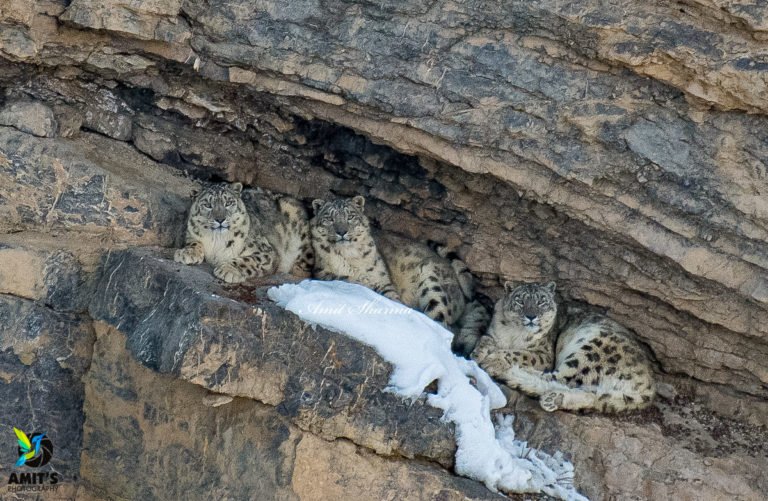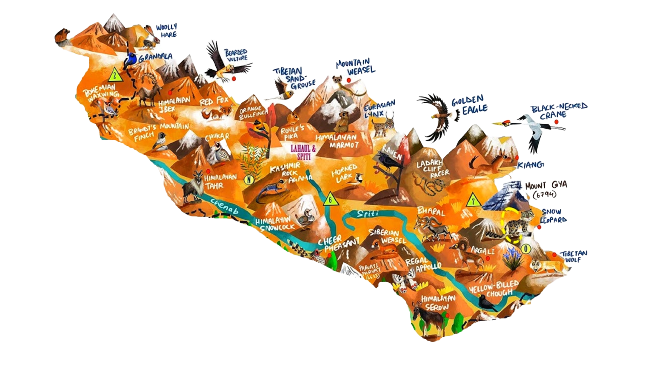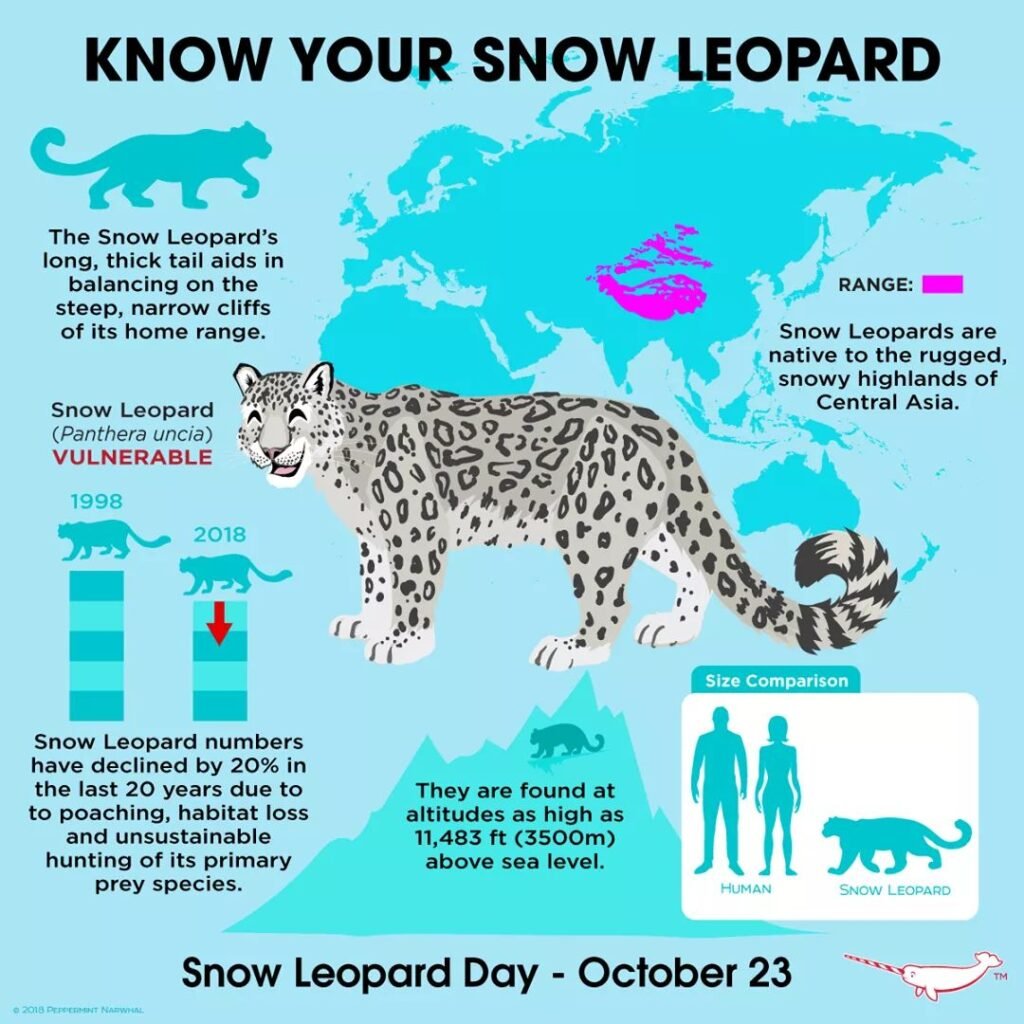
Snow Leopard Photo Tour in Spiti Valley (Kibber WLS)
it might strike you as both bizarre (and equally fascinating) to drive to Spiti valley and Kinnaur during wintertime. Though for solitude seekers and wildlife photographers — with a goal to unplug and get off-grid, or spot endangered (now vulnerable) snow leopards and assorted mammal and bird species in Kibber wildlife sanctuary — the snowscapes of the Spiti valley and Kinnaur Himalayas are a true refuge and a place for the mindful pause. Likewise, winter months are great to learn how the people of Spiti valley survive in freezing, sub-zero temperatures for months.
Snow Leopard Photo Expedition in Spiti (2023-24)
Snow Leopard Safari Rundown
| Best Time | December to March |
|---|---|
| Difficulty | Moderate |
| Altitude | 4270m (Kibber village) |
| Key wildlife species | Snow Leopards, Himalayan Ibex, Himalayan Blue Sheep, Red fox, Himalayan Snow Cock, White breasted stone / beech marten (aka Himalayan Weasel), Eurasian Lynx, Tibetan Sandgrouse, and Woolly Hare |
| Trip span | 9 Days and 8 Nights |
| Scheduled Events in 2024 | January 1, 12 and February 5, 15 |
| Activity | Hiking, wildlife spotting and photography |
The winter trip to Spiti has its own charm and vulnerabilities. The charm lies in the tranquillity — so peaceful that you would hear yourself breathing — of the Spiti valley, less to no crowd, snowy winter landscape, frequent sightings of rare Himalayan wildlife like snow leopards, no electricity, and no internet.
Kibber Wildlife Sanctuary (WLS) is also a part of 16th Cold Desert biosphere reserve(declared a biosphere reserve in 2009).
Wildlife found in Himalayan cold deserts (notably in Kibber WLS) are:
- Snow leopard
- Himalayan ibex
- Blue sheep (bharal)
- Tibetan wolf
- Red fox
- Number of bird species (like Kestrel, Finches, Chough, Larks, Red starts)
- Eurasian Lynx
- Tibetan Sandgrouse
- Himalayan wolf (Canis lupus)
- Long tailed marmot (Marmota caudata)
- Wooly Hare (Lepus oiostolus)
- Pika (Ochotona roylei)
Along with Pin Valley National Park, Kibber wildlife sanctuary has been identifiedas “Important Bird Area” by Birdlife International.
The cold deserts (Lahaul and Spiti district and upper Kinnaur region) in Himachal Pradesh cover about 20% of its total (55673 square km) geographical area. The Himalayan cold deserts have distinct cultural and geographical features. They are characterized with regions of:
- Low precipitation (due to rain shadow effect)
- Large difference in day and night temperatures
- Low humidity
- Short summers
- Freezing cold and windy winters
- Diverse flora and rare fauna
Spiti valley of Himachal Pradesh (which literally translates to an abode of snow) is located in trans Himalayan ranges, the outermost range of the Himalayas. Spiti is a place frozen in space and time with vast valleys, glaciers, interesting geological features and towering trans-Himalayan peaks.

These deep gorges near Chicham village are the sanctuary for Snow Leopards
The extreme environmental events like avalanches, snowstorms, landslides, and rockfalls are common is this part of Himachal Pradesh state. Rare Himalayan wildlife like Snow leopard has adapted their body to survive under such extreme climatic conditions.
Based on about a decade long snow leopard photography experience and working with local spotters, the team of Raacho Trekkers schedule theirsnow leopard expeditiontrips in January and February month.
How To Sight Snow Leopards In Kibber WLS?
Patience is key in a snow leopard expeditionas with any wildlife expedition. You need to be at the right spotting places at the right time. It is not an easy task to pursue these enigmatic cats who live and are prey on Himalayan blue sheep at an altitude well over 3, 500 meters from the sea level, at temperatures close to -30 degrees.

Wildlife map of Lahaul & Spiti district of Himachal
The right times are early morning and late evenings. And the right places are Kibber wildlife sanctuary and Kibber-Chicham village plateaux, slopes between Kee, Gete and Tashigang, Shilla Nalla area, plateau around Langza, Hikkim, Komic and slopes around Demul, Salung, Rama and Lalung.
Sighting and photography tips
Here are some tips to increase your chances of sighting the snow leopards.
- Hire local spotter/guides: They have the best knowledge of the terrain, the weather, best time and the spotting locations in their area. They can also help you with sanctuary/national park permits, logistics, and safety.
- Plan your trip after a snowfall: Snow leopards are easier to spot against a snowy background, as their grey fur stands out more. Snow also makes their tracks more visible, which can help you track them down.
- Be patient and persistent: Snow leopards are hailed as the master of camouflaging. They are rare and shy animals that can go unnoticed for days or weeks. You need to be prepared to spend long hours in the cold, waiting and watching for any sign of movement.
- Follow their prey: Snow leopards feed on mountain ungulates, such as ibexes and blue sheep. If you find these animals, you have a higher chance of finding a snow leopard nearby. Look for rocky outcrops, cliffs, and ledges where snow leopards like to ambush their prey.
- Study their behavior: Snow leopards have unique and fascinating habits that can help you understand and anticipate their actions. You can learn more about them from online resources, such as the Snow Leopard Trust and National Geographic, books, such as The Snow Leopard by Peter Matthiessen and Snow Leopard: Stories from the Roof of the World by Don Hunter, or talk to experts who have photographed snow leopards in the wild.
- Use the right equipment: Snow leopards are usually active at dawn and dusk, when the light is low and the colors are muted. You need a camera with a large aperture lens, a high ISO setting, and a fast shutter speed to capture sharp and clear images. You also need a sturdy tripod (Leofoto offers a great range of tripods for wildlife photography) to stabilize your camera and reduce camera shake.
- Capture the action: Snow leopards are agile and powerful hunters that can leap up to six times their body length. Shooting a snow leopard chasing an Ibex is a dream of every photographer. To photograph these spectacular moments, you need to use a continuous shooting mode and a fast shutter speed. You also need to be ready and alert, as these events can happen in a matter of seconds.
- Visit during the mating season: The best time to see and photograph snow leopards is from January to early March, when they are more active. This is also the time when they mate and form pairs. You can witness and capture the intimate and playful interactions of these elusive animals.
Drive To Kinnaur & Spiti valley in Winter
Snow drives to Kinnaur and the Spiti valleyin winter is a complete digital detox and an expedition itself.
The winter Spiti valley itinerary covers one of the most treacherous parts of NH5 and Sumdo to Kaza road. In winters, you get to know local life and culture more intimately and see for yourself how hard it is to survive in the Himalayas.

Infographic of Snow Leopard Habitat
The fragility & hardships of the winters in Spiti valley is punctuated by the limited road connectivity, driving on icy roads, no running tap water, limited warm water, subzero temperatures, and no room heating.
But the major concern is always the fragile road connectivity, which gets snapped when there is heavy snowfall and avalanches block the road for weeks.

Population estimate of Snow Leopards in Kibber WLS of Himachal Pradesh

The most frequent sighting has been in Kibber Plateau, slopes between Kee, Gete and Tashigang, Shilla Nalla area, plateau around Langza, Chicham, Hikkim, Komic and slopes around Demul, Salung, Rama and Lalung.
snow leopard population mappingwas done using 80 camera traps in upper Kinnaur (Asrang-Lippa wildlife sanctuary), Pin Valley, Baspa valley , Tabo, Tharot-Miyar, Bhaga, Chandra, and upper Spiti valley of Himachal Pradesh.
The International Union for Conservation of Nature is an international organization (IUCN), the apex body working in the field of nature conservation and sustainable use of natural resources, has put the Snow leopards in the vulnerable category in India.
In this category, the species are likely to become endangered unless the circumstances that are threatening its survival and reproduction improve.
Vulnerability is mainly caused by habitat loss or destruction of the species home. The situation is opposite in the Kinnaur and the Spiti valley of India where the population of snow leopards is growing.
Event Registration
Fields marked with an *are required



























































































